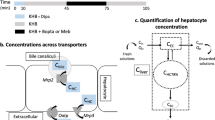Abstract
The kinetics of the iminodiacetic acids, dimethyl and diethyl IDA were studied in patients without and with liver disease. Diethyl IDA seems to be superior to dimethyl IDA in its diagnostic usefulness. It shows lower urinary excretion and a faster live uptake, leading to more pronounced differences in live peak time and in liver elimination half time and to faster visualisation of the gall bladder in patients with liver disease. The enterohepatic reabsorption is negligible as shown by enteral administration of the radiopharmaceutical and monitoring blood activity. Therefore it is not necessary to correct time activity curves of the liver for the IDA secreted into the gastrointestinal system. The most valuable diagnostic information with this substances may be gained in investigations on cholecystectomized patients with cholestasis.
Similar content being viewed by others
References
Biersack, H.J., Thelen, M., Breuel, H.P., Winkler, C.: 99mTc Hepatobida zur Funktionsszintigraphie der Leber. Nuc. Compact. 8, 3–6 (1977)
Callery, P.S., Faith, W.C., Loberg, M.D., Fields, A., Harvey, E., Cooper, M.: Tissue distribution of 99mTc and carbon 14-labelled N (2,6-dimethylphenylcarbamoyl methyl) iminodiacetic acid. I. Med. Chem. 19, 962 (1976)
Harvey, E., Loberg, M.D., Cooper, M.: Tc 99m-HIDA: a new radiopharmaceutical for hepatobiliary imaging. J. Nucl. Med. 16, 533 (1975)
Hirom, P.C., Millburn, P., Smith, R.L.: Bile and urine as complementary, pathways for the excretion of foreign organic compounds. Xenobiotica 6, 55–64 (1976)
Loberg, M.D., Cooper, M., Harvey, E., Callery, P.S., Faith, W.: Development of new radiopharmaceuticals based on N-substitution of iminodiacetic acid. J. Nucl. Med. 17, 633–638 (1976)
Löfgren, N.M., Lundquist, B.J.: Alkylglycinanilides. Chem. Abstr. 42, 6378–6379 (1948)
Millburn, P.: Factors in the biliary excretion of organic compounds. In: Metabolic conjugation and metabolic hydrolysis. Fishman W.H. (ed.), Vol. 2, pp. 1–70. New York: Academic Press 1970
Neilson, P., Rasmussen, F.: Minireview — Relationships between molecular structure and excretion of drugs. Life Sci. 17, 1495–1512 (1975)
Ronai, P.M.: hepatobiliary radiopharmaceuticals: defining their clincial role will be a galling experience (Editorial). J. Nucl. Med. 18, 488–489 (1977)
Wistow, B.W., Subramanian, G., Van Heertum, R.L., Henderson, R.W., Gagne, R.M., Hall, R.C., McAfee, J.G.: An evaluation of 99mTc-labeled hepatobiliary agents. J. Nucl. Med. 18, 455–461 (1977)
Author information
Authors and Affiliations
Rights and permissions
About this article
Cite this article
Dudczak, R., Kletter, K., Angelberger, P. et al. Comparison of two different biliary agents in healthy subjects and in patients with liver disease. Eur J Nucl Med 4, 365–368 (1979). https://doi.org/10.1007/BF00263305
Received:
Issue Date:
DOI: https://doi.org/10.1007/BF00263305




